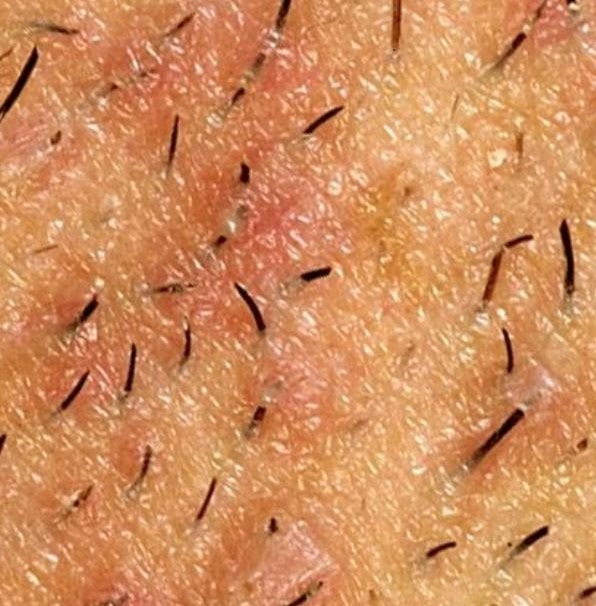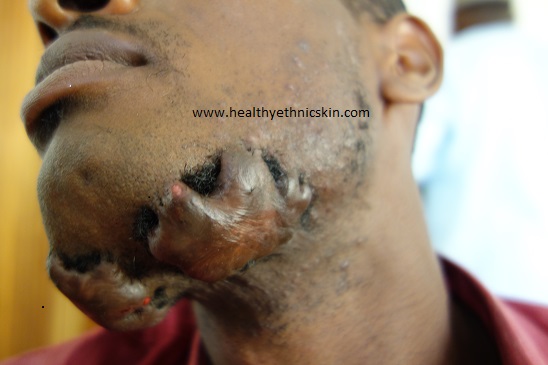Pseudofolliculitis (PF), also known as shave bumps, razor bumps, the shave itch, ingrown hair and barber’s devil is a very common skin condition peculiar to males and females who have curly and coarse hair. These are mainly people of Ethnic descent.
It can occur on any hair bearing area where the hair grows very curly and is shaved very close to the skin. This includes the face (pseudofolliculitis barbae), the chest, the back of the scalp (pseudofolliculitis nuchae), the pubic area (pseudofolliculitis pubis), armpits and other hair bearing areas.

For the purpose of this discussion, a strand of hair has can be said to have 2 parts, the part within the skin which is covered/sheathed by the hair follicle and the part above the skin which we see- the hair shaft. This unsheathed hair is made of keratin protein. When hair is cut very close to the skin and the hair shaft begins to grow, it either curls within itself into the same hair follicle (ingrown hair in illustration 3 below), or it grows out of the skin and re-pierces it along its curly path (shaving bump in illustration 4 below) therefore growing into another follicle.

When the unsheathed hair that is meant to be outside the skin is retained within it, the skin sees this as a foreign body and the immune system mounts a defense against it resulting in a foreign body reaction. The foreign body reaction results in an inflammation which leads to the redness, itching and swelling experienced in PF. If it progresses, this inflammation can lead to pain, infection, scarring and even the development of keloids.


The only cure for PF is to avoid shaving. In situations where this is not possible, proper education helps the patient understand and imbibe better shaving practices to minimize PF.
To manage and minimize PF one has to avoid shaving real close and leaving a residual sharp tip. Also one should avoid pulling hair and making it snap and recoil within the skin. The following advice is very helpful:
- A single blade should be used. Multiple blades give very close shaves and leave very sharp hairs.
- Avoid pulling the skin to make it taut/tight before shaving as this leads to a very close shave with very short, sharp hairs buried in the skin.
- Shave in the direction of hair growth and avoid going over the shaved area multiple times with the blade..
- Use an electric shaver or clipper to lessen chances of a very close shave.
- Depilatory creams dissolve the hairs leaving them blunt. Avoid leaving these creams on for too long as they can irritate the skin.
- Shave after a shower, after wetting hair, or following use of shaving creams. This makes the hair softer more blunt than sharp.
- Avoid tweezing & plucking, the residual hair snaps back into the follicle following this.
- If the above are unhelpful, one should consider trimming the hair with a scissors rather than shaving.
In situations where the bumps are already present, it is advisable to let the hair grow out a little before shaving or trimming again.
Treatment will depend on the degree and stage of PF. Early cases benefit from keratolytics which are medicaments that soften and shed the outer skin layers, thereby reducing chances of the hair getting trapped in the skin. Examples of keratolytics used in our practice include but are not limited to tretinoin, salicylic acid, lactic acid and glycolic acid. For cases with severe inflammation, a low potency steroid cream along with the keratolytic will suffice. In cases with infection, topical or systemic antibiotics with anti-inflammatory properties like tetracycline, clindamycin, doxycycline are beneficial.
There are creams that slow down hair growth for as long as they are being used. They are of great benefit to those suffering from this condition.
More recently the introduction of lasers and their use in hair removal has brought great promise to the management of PF. Nd:YAG lasers have been safely used in ethnic skin to permanently reduce unwanted hair and its concomitant problems. A minimum of 6 to 10 monthly sessions of laser are required with 1 to 2 sessions every year thereafter to maintain the results. Lasers are serious devices that should be handled and administered by only professionals trained in their use.
The management of PF can be frustrating for both the patient and the physician but many patients get good results once they understand the condition and find ways of working around it.
Comments & Questions are welcome. Please forward to anyone that you think will benefit from this information.
